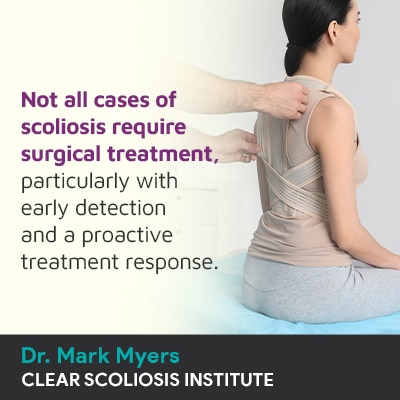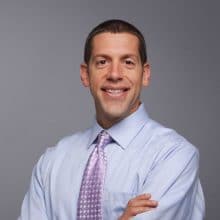
For people recently diagnosed with scoliosis, they have a lot of questions, one of which is how best to treat the condition. Reversing scoliosis means reducing the size of the unnatural spinal curve as this is addressing the condition’s underlying structural nature.
The two main scoliosis treatment approaches offer a surgical, or non-surgical response. For those interested in a non-invasive more-natural approach to reversing scoliosis, there is the option of conservative chiropractic-centered treatment.
Before a treatment approach can be decided upon, conditions have to be classified accordingly, and this is part of diagnosing scoliosis.
People with scoliosis have developed an unnatural sideways curvature of the spine, and this means the spine has lost one or more of its healthy curves; the spine’s natural curves make it stronger, less vulnerable to injury, more flexible, and facilitate its ability to handle stress from impact and activity.
A scoliotic spine doesn't just bend unnaturally, it also rotates, and this twisting component makes scoliosis a 3-dimensional condition.
In addition, an unnatural spinal curve has to be of a minimum size to be considered a true scoliosis; that’s determined by a measurement known as Cobb angle.
A patient’s Cobb angle is a key piece of information that treatment plans are shaped around, and the higher a patient’s Cobb angle, the more out of alignment the spine is, the more severe the condition, and the more overt its effects are likely to be.
When it comes to the effects of scoliosis, as you can see from the wide range of Cobb angle measurements, each case is different, but the main effect of scoliosis in children is postural deviation; in adults, it’s pain.
Scoliosis becomes a compressive condition once growth has stopped; the constant lengthening motion of a growing spine counteracts the compressive force of the unnatural spinal curve, and it’s compression of the spine and its surrounding muscles and nerves that makes scoliosis painful for adults.
Scoliosis isn’t just a complex 3-dimensional spinal condition, it’s also a progressive condition, so its nature is to get worse over time, and while we don’t always understand why scoliosis develops initially, we do know it’s growth that triggers progression.
Young patients who have not yet reached skeletal maturity are the most at risk for rapid progression, so when treating scoliosis in children, particularly adolescents going through puberty, a focus of treatment is closely monitoring the spine to see how it responds to growth.
The goal of treatment for adolescent idiopathic scoliosis (AIS) is to achieve a significant curvature reduction and sustain it through proactive treatment that consistently counteracts the condition’s progressive nature.
Let’s now talk about the two main scoliosis treatment approaches and the different potential outcomes they offer patients.

Committing to a scoliosis treatment approach means working towards a certain goal, and when we’re talking about traditional treatment, that goal is stopping progression, and in conservative treatment, the goal is correcting scoliosis: two different approaches and goals that affect spinal health differently.
I want patients to fully understand the pros and cons of each treatment approach, along with the benefits associated with more-natural forms of treatment so they are informed and can make educated treatment choices.
Traditional scoliosis treatment is less natural and proactive; it’s less natural because it tends to direct patients towards invasive spinal fusion surgery, and it’s not considered proactive because it doesn’t prioritize attempting to prevent progression by starting treatment early in a condition’s progressive line.
Traditional treatment doesn’t have a strategy for addressing scoliosis while mild, and this is precisely when scoliosis is the simplest to treat: while it’s still mild, the curve size is small, and significant progression hasn’t yet occurred.
For patients on the path of traditional scoliosis treatment, when/if they progress into the severe classification with a Cobb angle measurement of 40+ degrees, further progression is likely and patients become surgical candidates.
Traditional treatment offers a reactive surgical response, and this involves spinal fusion surgery that fuses the vertebrae at the curve’s apex into one solid bone, and this can stop those vertebral bodies from becoming more tilted over time (progression); however, fusing the spine conflicts with its movement-based structure and design so can come at a cost.
Some patients maintain enough spinal flexibility above and below the fused portion of the spine post-spinal fusion, but many experience a noticeable loss in spinal flexibility and range of motion (ROM), and this is an effect that can impact a patient’s quality of life, particularly if it means being unable to participate in certain activities.
Spinal fusion also commonly involves attaching rods to the spine to maintain its position, and hardware attached is permanent; if hardware should fail in the future, there is no recourse other than more surgery, and the risks only increase with age and each additional surgery.
So while spinal fusion surgery can straighten a bent spine, the way it achieves its goal, through a reactive surgical response, can ultimately make the spine weaker, more vulnerable to injury, and less functional.
A surgical response can carry both short- and long-term effects, and the procedure itself is associated with the following potential risks:
While a traditional approach can still have a place in the treatment of scoliosis, in many cases, a more-natural approach is also capable of impacting conditions on every level, and doesn’t carry as many negative potential effects involving spinal strength and function.

Here at the CLEAR Scoliosis Institute, our results have shown a more natural less-invasive treatment approach can help reduce patients’ scoliosis on a structural level.
Treatment starts with a variety of therapies that help prepare the body and spine for treatment; massage and other therapies can relax the spine and its surrounding muscles, making the area more responsive to treatment.
Scoliosis is a structural spinal condition, so the main impact of treatment has to be on a structural level, and conservative treatment works towards this through condition-specific chiropractic care that can include a number of techniques and manual adjustments.
Manual adjustments work towards repositioning the scoliotic spine’s most-tilted vertebrae back into alignment with the rest of the spine, and this is known as a curvature reduction: restoring as much of the spine’s natural and healthy curves as possible.
A number of therapies are also applied as part of treatment to impact conditions on other levels; condition-specific physical therapy and scoliosis-specific exercises (SSEs) can help increase core strength as it’s not just the spine that maintains its natural curves and alignment, but also its surrounding muscles that provide it with crucial support.
Physical therapy and scoliosis-specific exercises can also help improve posture, balance, coordination, address any muscle imbalance, and stimulate areas of the brain for better communication.
In addition, corrective bracing can be another facet of conservative scoliosis treatment, and this is particularly common when treating the condition’s most prevalent form: adolescent idiopathic scoliosis.
When combined with other scoliosis-specific treatment disciplines, corrective bracing can complement those other disciplines and help augment corrective results.
Achieving corrective results is a different goal than stopping progression. Stopping progression is just that: stopping conditions from getting worse.
Achieving corrective results is more than just stopping progression because it’s impacting the condition on a structural level, and it does so through a safe and non-invasive approach that's more aligned with the spine’s natural design and function.
When patients ask if scoliosis can be reversed naturally, they generally mean non-surgically, and the answer is a resounding YES!!
While there are never treatment guarantees, particularly in cases that were diagnosed early and responded to with conservative treatment started as close to the time of diagnosis as possible, corrective results can be within reach.
Reversing scoliosis means reducing the size of the scoliotic curve on a structural level, and increasing spinal support by improving core-muscle strength, and while no single treatment discipline is enough to reverse a scoliosis on its own, when multiple condition-specific treatment disciplines are integrated into a customized treatment plan, conditions can be impacted on multiple levels.
Corrective bracing can be particularly effective on growing spines, and rehabilitation can include continued chiropractic care and home exercises that help further strengthen, heal, and stabilize the spine.
As a CLEAR-certified scoliosis chiropractor, I want to improve the health of the entire spine by restoring as much of its healthy curves and alignment as possible, and I want to achieve this through treatment that helps preserve the spine’s natural strength and function.

CLEAR provides a unique and innovative way of understanding scoliosis. Sign up to receive facts and information you won’t find anywhere else.
